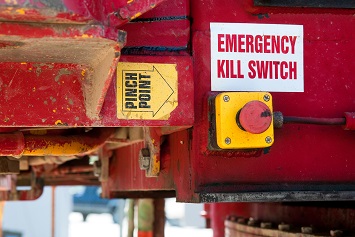OSHA recently cited an Ohio tool manufacturer for not providing adequate protection to an employee who suffered a partial finger amputation when he was caught in the pinch point of a conveyor belt. The employer faces a $213,411 penalty. The company was cited for a similar violation in 2016, says OSHA, which has placed the alleged violator in its Severe Violator Enforcement Program.
What Are Pinch Points?
A pinch point or nip point is any point at which it is possible for a person or part of a person’s body to be caught between moving parts of a machine or between the moving and stationary parts of a machine or between material and any part of the machine. At least one moving part of the machine must have a rotary or circular motion. Typical nip points include gears, rollers, belt drives, and pulleys. Machines with pinch points include metal-forming machines, power presses, conveyors, robotic machines, powered rollers, assembling machines, plastic molding machinery, printing presses, powered benders, press brakes, power transmission equipment, powered doors, covers, and hatches, including such generally unrecognized hazards like overhead, powered garage-type sliding doors.
Protections for employees who work with machines with pinch point hazards are contained in OSHA standards for agriculture, general industry, marine terminals, longshoring, and construction.
Guards and Devices
A guard to isolate the worker from the pinch point is the most common form of protection in OSHA’s standards. OSHA has also recognized that protection from pinch point accidents can be provided by what it calls devices. These items will stop the machine if a hand or any body part is inadvertently placed in the danger area; restrain or withdraw the operator’s hands from the danger area during operation; require the operator to use both hands on machine controls; or provide a barrier that is synchronized with the operating cycle of the machine. Machine stoppage can be achieved by multiple means, including photoelectric (optical) or radio frequency (the machine stops when its capacitance field is interrupted).
OSHA has written guidance on preventing pinch point accidents for several industries. The following recommendations were provided for woodworking and are also relevant to other sectors in which machines with pinch points pose hazards to workers (https://www.osha.gov/SLTC/etools/woodworking/nippoints.html).
Engineering controls
- Guards. If you purchase a machine that does not come equipped with a guard, install one. Contact the manufacturer of the machine to see if appropriate guards are available for the equipment. Guards should always be designed and installed by technically competent and qualified persons. Have the equipment manufacturer review proposed guard designs to ensure that the guard will adequately protect employees and allow safe operation of the equipment.
- Ways to guard. The choice of guards is determined by the design of the machine, the manufactured material, the work being performed, and other factors. All moving machine parts that may cause injury must be safeguarded.
- Securing guards. Workers should not be able to easily bypass, remove, or otherwise tamper with the guard.
- Durability. Guards must have adequate strength to resist blows and other operational stresses.
Work practice controls
- Training. Workers should understand the purpose and function of all controls on the machine, should know how to stop the equipment in an emergency, should be trained on the safety procedures for special setups, should know the circumstances under which the guard should be removed (usually just for maintenance), and what to do if the guard is damaged or not functioning properly. Employees should be able to demonstrate their ability to run the machine with all safety precautions and mechanisms in place.
- Inspection. Inspections should ensure that the operator and the machine are equipped with the safety accessories suitable for the hazards of the job, the machine and safety equipment are in proper working condition, and the machine operator is properly trained. Inspections should be documented and records maintained.
- Use the guards. A worker should not be allowed to operate a piece of equipment if the guard or any other safety device is not functioning properly.
- Shut off the machine. Workers should know never to leave a machine that has been turned off but is still coasting.
- Housekeeping. Keep floors and aisles in good repair and free from debris, dust, protruding nails, unevenness, or other tripping hazards. Make sure the floor is nonslip.
And always remember, use appropriate personal protective equipment.

